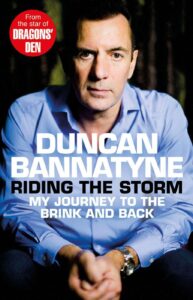
Question More, Action Knowledge.
Remember, at QMAK, we don’t just teach; we empower. We don’t just inform; we inspire. We don’t just question; we act. Become a Gold Member, and let’s unlock your child’s full potential, one question at a time.
 As a homeschooling parent, you want to equip your child with the skills and mindset they need to thrive in an ever-changing world. And in today’s entrepreneurial landscape, one of the most valuable qualities you can nurture is the ability to take calculated risks.
As a homeschooling parent, you want to equip your child with the skills and mindset they need to thrive in an ever-changing world. And in today’s entrepreneurial landscape, one of the most valuable qualities you can nurture is the ability to take calculated risks.
But how do you teach your child to embrace risk-taking without putting them in harm’s way?
Look no further than the insights of self-made entrepreneur Duncan Bannatyne, whose autobiography “Riding the Storm” offers a masterclass in navigating the high-stakes world of business.
Throughout his entrepreneurial journey, from his early ventures in the ice cream industry to his multi-million pound empire spanning health clubs, hotels, and property, Bannatyne has demonstrated a keen understanding of the power and pitfalls of risk-taking. He emphasizes the importance of thorough research, due diligence, and risk mitigation strategies, while also acknowledging that no success comes without a willingness to step outside one’s comfort zone.
So, how can you help your homeschooler develop a healthy relationship with risk-taking?
Here are some practical insights and activities inspired by Bannatyne’s approach:
1. Teach them to do their homework. Before embarking on any entrepreneurial venture, Bannatyne stresses the importance of conducting thorough market research and feasibility studies. Encourage your child to adopt the same diligent approach by researching their target market, analyzing competitors, and identifying potential challenges and opportunities. This could involve conducting surveys, interviewing potential customers, or creating a SWOT analysis of their business idea.
2. Help them develop a risk assessment framework. Not all risks are created equal, and it’s essential for young entrepreneurs to learn how to distinguish between calculated risks and reckless gambles. Help your child develop a risk assessment framework that takes into account factors such as potential reward, probability of success, and worst-case scenarios. This could involve creating a decision tree or using a risk matrix to visualize and prioritize different options.
3. Encourage them to start small and scale gradually. Bannatyne’s entrepreneurial journey began with a single ice cream van, which he gradually grew into a fleet before expanding into other industries. Teach your child the value of starting small and testing their ideas on a limited scale before investing significant resources. This could involve launching a minimum viable product, conducting a pilot program, or setting up a pop-up shop to gauge customer interest.
4. Foster a culture of experimentation and learning. Bannatyne’s autobiography is filled with examples of both successful and unsuccessful ventures, each of which taught him valuable lessons about business and life. Encourage your child to view their entrepreneurial pursuits as an ongoing experiment, where failure is not a setback but an opportunity for growth and learning. Celebrate their efforts and progress, and help them reflect on the lessons learned from each experience.
5. Teach them to manage and mitigate risks. While some risks are unavoidable, successful entrepreneurs know how to manage and mitigate potential downsides. Teach your child strategies for reducing risk, such as diversifying their investments, building contingency plans, and securing appropriate insurance and legal protections. Encourage them to seek out mentors and advisors who can provide guidance and support in navigating the challenges of entrepreneurship.
By incorporating these insights and activities into your homeschooling approach, you’ll be helping your child develop the skills and mindset they need to thrive in an uncertain world. But more than that, you’ll be nurturing a sense of courage, resilience, and adaptability that will serve them well in all aspects of life.
As Bannatyne’s story illustrates, the path of entrepreneurship is never a straight line. It’s a journey filled with twists, turns, and unexpected obstacles. But it’s also a journey that rewards those who are willing to take calculated risks, learn from their mistakes, and persist in the face of adversity.
So, encourage your homeschooler to embrace the power of calculated risk-taking. Help them develop the tools and frameworks they need to assess and manage risk, while also fostering a culture of experimentation and learning. And most importantly, inspire them to believe in themselves and their abilities, just like Duncan Bannatyne did when he took that first leap of faith with his ice cream van.
With your guidance and support, your child can learn to navigate the uncertainties of entrepreneurship with confidence and resilience. And who knows – they may just become the next Duncan Bannatyne, inspiring a new generation of risk-takers and change-makers.

Remember, at QMAK, we don’t just teach; we empower. We don’t just inform; we inspire. We don’t just question; we act. Become a Gold Member, and let’s unlock your child’s full potential, one question at a time.